ARCHIVE: PAST WORK Click to return to Series for Exhibition.

Artist’s Statement: Sea Reflection, 2004/05
The world is large, but in us it is as deep as the sea.
R.M. RILKE
This undersea work is about reflection and metamorphosis. It is about looking into the depths, specifically deep into the sea. It’s about losing a grounding gravitational hold, floating suspended in time, and allowing imagination and the unconscious to inform what I see.
I am creating new life forms from ordinary garden pants. A common burr becomes a crawling anemone, a thistle transforms into a coral reef. Photographing, cropping, duplicating, mirroring and layering produce an endless variety of new organisms. I then combine the photography with traditional painting and glazing techniques. The work is technologically altered, nature manipulated and viewed through a liquid lens.
Although it is water which sustains life on the most basic level, its depths are also the most enigmatic, home to both wondrous new life forms and to monstrous unknown danger. It is these depths, within the ocean, our world around us and within ourselves that I explore.
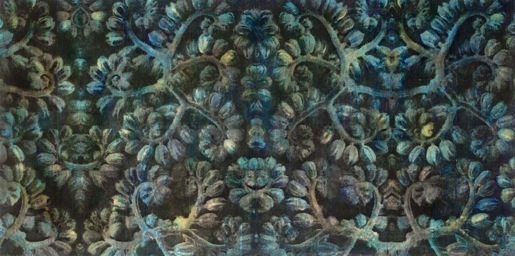
Artist’s Statement: Intimate Immensity (The Pregnancy Project II), 2003
I held a small ocean within me, cradling my child. Water sustained us—enveloping my son, quenching my thirst, overflowing the earth.
FRANCIE RANDOLPH
This series of pregnant nudes celebrates largeness, roundness, fullness: the cycle of life. The photographs are about being big, and seeing the beauty in getting bigger. They are about a very intimate immensity. The images capture unique and fleeting moments of a woman’s life when she houses another within, sustaining with her own physical greatness of being.
Cyanotype photography, one of the earliest forms of photography, uses only the sun and water to capture an image on the emulsion. I begin by painting cyanotype emulsion onto large sheets of paper. I then make a photogram, or contact print, using my pregnant body. The paper and body are exposed to sunlight, then the photogram is rinsed in a water bath until the emulsion not “fixed” by the sun rinses out.
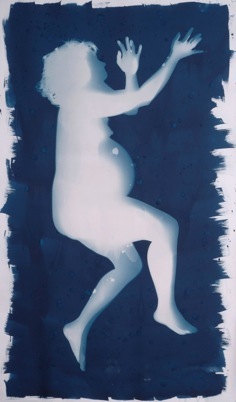
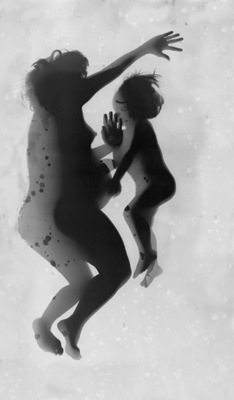
Artist’s Statement: New Geography, 2002
Space, outside ourselves, invades and ravishes things:
If you want to achieve the existence of a tree,
Invest it with inner space, this space
That has its being in you.
RAINER MARIA RILKE
The New Geography Series is a search for new perception: a continued attempt to see the presence of perfectly familiar subjects in a new way. In spite of a disturbed world, in spite of daily distractions, the magnified focus offers a new geography and fresh impact. I see what I hadn’t noticed before, what I had taken for granted looks new again, I recognize similarities and differences not previously acknowledged.
In the stillness of discovering detail, a quiet calm emerges. This concentration can intensify the viewing, the senses. The act of creating these images is meditative yet offers as much surprise as life itself. Through this close and intimate examination of the world the patterns which connect us appear. The continued discovery of new ways of seeing draws together two worlds: the immense external world and the intimate world that exists within.

Artist’s Statement: In the Moment of Unravelling, 2001
These ferns depict moments of unfurling, a plant poised for life and its potential. Through technological manipulation and reconfiguration of the botanical image, the work explores the relationship of science and nature as well as the human urge to “improve”.
In the Moment of Unraveling exposes the fern: a primitive life form whose genetic make-up is naturally “fractal” the mathematical term for a part which contains within it the structure of the whole. One leaf of a frond mimics the structure of the complete frond; one branch of a leaf mimics the structure of the leaf itself, etc. My technique parallels this challenge to the concept of wholeness.
I have scanned photographs into the computer and altered them, sometimes just slightly and sometimes more so. By manipulating the plants in the computer, altering scale, cloning parts, and deleting sections, I change the make-up of what naturally existed. What is real? What is technologically altered? I explore the concept of reconfiguration, the marriage of new and old, culture and nature.
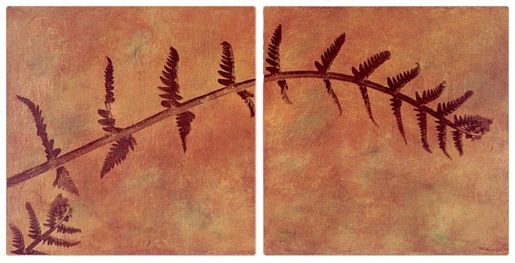
Artist’s Statement: Body Matrix (The Pregnancy Project I), 2000
matrix, n., pl. matrices. 1. that which gives origin or form to a thing, or which serves to enclose it. 2. Anat. a formative part. 3. Biol. the intercellular substance of a tissue. 4. Math. the rectangular arrangement into rows and columns of the elements of a set. 5. Archaic. the womb. [< LATIN: mater, mother]
The Body Matrix series focuses on various meanings of the word matrix. The individual “cells” of the grid join together to form large images of pregnant nudes. By breaking the photograph apart, printing each piece separately and then reconfiguring them on a painted panel, and by cropping tightly on nearly abstracted sections of the body, I investigate the relationship of a part to the whole.
Advances in reproductive technologies, both in terms of reproducing (printing) an image and of reproducing (cloning) a biological organism, play into my work. The photography, computer work and printing methods explore new developments in digital technologies. I then combine my photos with traditional painting materials – canvas, graphite, paint – to explore how the high-tech can be coupled with traditional modes of art-making. In addition to my technique, my chosen subject matter is an inquiry into perceived opposites.

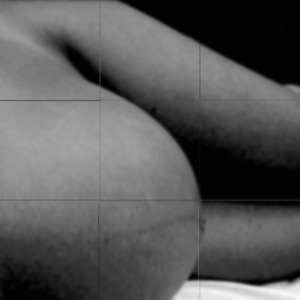
Artist’s Statement: Dehiscence, 1998/99
The painter’s eye attends to birth and death
Together, seeing a single energy
Momently manifest in every form,
As in the tree the growing of the tree
Exploding from the seed not more nor less
Than from the void condensing down and in
Summoning sun and rain.
HOWARD NEMEROV
The Dehiscence series focuses on botanical form and cycles of growth. Life, death, and regeneration are distilled in these forms, uncomplicated by tradition, fear, and human ego. Desiccation in the plant world yields an opening of seed pods, a giving forth of fruit for future generations. The raw beauty of the entire range of plant life from germination to decay, the infinite variety of forms within a preordained genetic pattern of growth, and the fundamental desire for maximum development, intrigue me. My work is a visual exploration into this life cycle, the continuum from birth to death to birth.
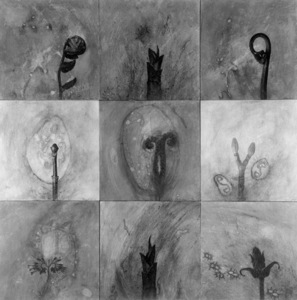
Artist’s Statement: Natural Metaphors, 1996/97
The depth of life is entirely revealed in the spectacle, however ordinary, that we have before our eyes, and which becomes the symbol of it.
BAUDELAIRE
Archetypal structure is a common link among all organisms; similarities exist in identical stages of life throughout different species. In many organisms we can see nearing the end of life’s cycle as a sublime process. Yet a person, distinguished from other organisms by emotional ability, comprehends an end to an individual cycle of growing old. Can we see the beauty in human aging if our knowledge of tradition, fear, and human ego cloud our vision? The mystery, for me, is in the question: What are the differences in seeing and knowing?
This series couples traditional drawing and painting techniques with recent computer imaging and printing technology. The art form itself explores intersections of dualities. Below the facile oppositional relationships of traditional painting/ high-tech computer work, nature/culture, and birth/death, there exist intricate and complex links. My work embodies a fascination for these shared places, common ground which, when explored, can engender symbiosis and growth.
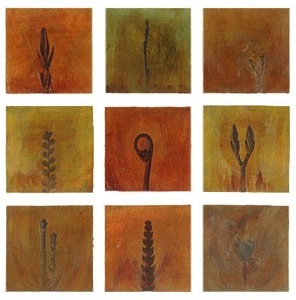
Artist’s Statement: Eureka, 1994/95
The Eureka Series addresses traditional societal stereotypes by focusing on both the vacuum and women’s bodies. The pictorial, aesthetic elements of these prints challenge conventional ideas about women and vacuums. Analogy, the combination of two similar elements, and metaphor, the substitution of one image for another, play a large part in my work, skewing images to create ironic relationships. Through manipulating, interpreting, and juxtaposing familiar icons I try to reach a responsive chord in the viewer by transcending the obvious.
The seven pieces in the series are ink jet prints and utilize the latest computer printing technology. The idea that the art form, as well as the topic addressed, breaks with tradition is a seductive one to me. Miles Unger in Art New England (2/94) states, “whether we embrace the new technologies wholeheartedly or bemoan their assault on traditional forms and practices, it is clear that in a world that is increasingly networked and digitized, art cannot simply cling to the past.” It is my belief that a distinct parallel can be drawn for the traditional role of women in American society.
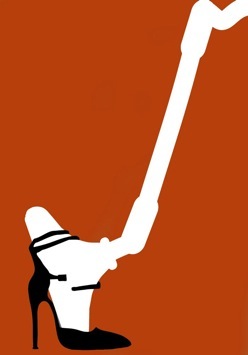
Artist’s Statement: Visions of Choice, 1992/93
As a woman I am disturbed by much of our country’s lack of respect for the female mind and body. As an artist I feel I best communicate my ideas visually. I have created this series to begin a thought process, a discussion, an analysis of personal belief.
Visions of Choice, first shown prior to the 1992 presidential elections, examines the frightening prospect of government legislation, of losing a woman’s fundamental right to determine what happens within her. Individually each poster works to engage its viewer; together they rigorously question a woman’s loss of control over her own body.
I have tried to create a series which will reverberate within one’s head, demanding an analysis of the issues involved in Choice. This process will encourage individuals to confront the issues on a personal rather than an institutional level, and, if successful, will be one small step toward increased communication and greater understanding of the issues faced by a woman in America today.
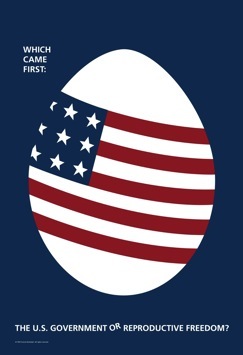
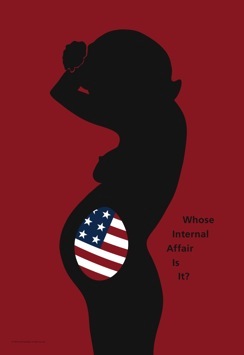

© Francie Randolph, 2010. All rights reserved.
home | current work | archive | truro studio | biography | calendar/press | contact | site map